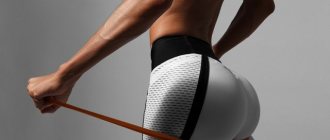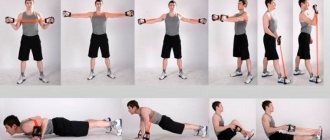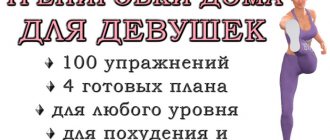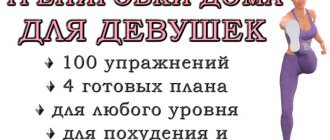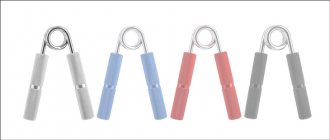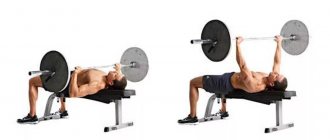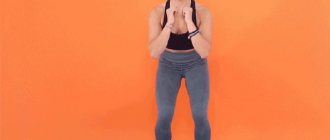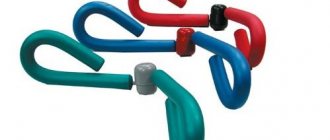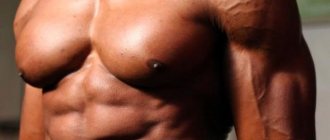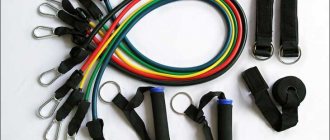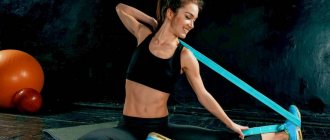Squats with a band appeared as a warm-up option for the classic squat. They allow you to load the buttocks and hip abductors a little more, so they quickly gained popularity. Over time, they began to be made by everyone who dreams of finding a “strong rear.” Today, round rubber shock absorbers can be bought anywhere, including Lenta stores. Only the lazy do not do this version of the squat. Why is the movement better or worse than the classic version?
Pros and cons of the exercise
Benefits of squatting with a band:
- The main advantage is the presence of additional load on the buttocks in the absence of vertical axial load on the spine. The exercise helps tone your muscles even if you are not squatting with a barbell;
- The exercise can be done anywhere, it is suitable for home training;
- It can be performed in multiple repetitions, which helps develop endurance;
- Can be used as an aid for various technical errors of the classic squat - bringing the knees inward, “pecking” with the pelvis and insufficient work of the knees to the sides;
- Allows the use of additional weights. Experienced practitioners can hold a dumbbell, barbell, or sandbag on their chest. There is also the option of using a round shock absorber in a classic barbell squat;
- Can be performed with a wide variety of available equipment. Some will buy a ring shock absorber, some will tie a regular elastic band from the pharmacy, and some will use a Pilates band. There is no fundamental difference here, the main thing is to get additional load.
Flaws:
- Progress in squats with an elastic band is finite. Shock absorbers from the mass market are quite “low-power”. An experienced athlete will be forced to either perform the exercise in an almost aerobic mode, or look for increasingly rigid shock absorbers. The latter are only available from brands that produce powerlifting equipment, and they are quite expensive;
- Overusing the band squat can cause injury to the hip abductors and cruciate ligaments of the knee;
- The exercise does not put additional stress on the hamstrings and quadriceps. And the load on the gluteus maximus greatly depends on the technique;
- Movement is overrated in women's training. Often, novice athletes and illiterate coaches replace the entire training of the “lower half” of the body with swings with an elastic band on the buttocks, because the muscles do not develop harmoniously enough.
Gluteal - squats with an elastic band without weight
What is an elastic band for sports
Essentially, this is an elastic strip closed in a ring, which, during physical exercises, needs to be stretched with different amplitudes. The accessory is called differently: fitness elastic band, expander loop, mini-band, leg expander, mini band, mini loop, resistance band, etc.
Not to be confused with rubber loops and elastic bands. The difference from the former is in the size of the ring (the loops have a much larger diameter), while the latter are not closed at all.
Elastic bands can have different levels of rigidity, allowing athletes to increase or decrease the load. If you plan to exercise seriously, we recommend that you immediately purchase a set of expanders with different resistances. This way you will be able to create an adequate load for various muscles.
What muscles work
There is an opinion that the elastic band is the best exercise machine for pumping up the gluteal muscles. But that's not true. The muscle is too strong to receive a high load from hip abduction with resistance. Therefore, the movement should still be considered complex, and not focused on working the buttocks.
Main muscles:
- hip abductor;
- gluteus maximus;
- quadriceps and hamstrings equally
Auxiliary:
- adductor muscles;
- tailoring;
- gastrocnemius and soleus
It is often written that the muscles of the back and abdomen work in static conditions, but one must understand that without the use of axial weights (barbell, dumbbells) it will be minimal.
Is it possible to pump up your arms using rubber expanders?
By using fitness bands in your home workout, you can tighten your arm muscles and tone them. By maintaining regular exercise and increasing the resistance level of the equipment, over time you will be able to achieve sculpted arms (in the absence of excess weight) and achieve a slight increase in muscle mass.
Definitely, your appearance will change, but still, free weights (barbells, dumbbells) will be more beneficial for gaining a large amount of muscle mass. Although, with due diligence and the use of high-resistance rubber, muscle growth will be noticeable even when exercising at home.
Execution technique
The exercise can be performed both with a shock absorber above the knees and below the knees. If there are problems with starting in a classic squat (the athlete stretches his pelvis back, rather than spreading his knees to the sides), use a shock absorber placed around the knees.
The procedure is as follows:
- Place the shock absorber at the desired height;
- Get into the starting position for a squat - spread your knees to the sides, feet at the width of your pelvic bones or slightly wider, the weight is distributed evenly between the heel and toe;
- The toes should be pointed moderately to the sides, exactly the width that gives a stable position to the feet and does not interfere with the work of the knees;
- The shoulder blades are collected towards the spine, the stomach is retracted. You can cross your arms in front of your chest or leave them along your body. Placing your hands and your head helps you control your back and keep it upright. But at the same time, it complicates the exercise;
- The knees move to the sides and bend at the same time;
- Next, the hip joint bends, the pelvis drops below the plane of the knees;
- Downward movement - while inhaling;
- As soon as the optimal depth is reached, a breath is taken, then the feet press into the floor, and first the hip joints are extended, then the knee joints;
- The exercise can be performed both in full amplitude and along a shortened trajectory, when the knees do not fully extend at the top point.
Squats with rubber: technique and nuances
Features of squats with rubber
If you are wondering how to squat with a fitness band, imagine doing your usual exercises, but with a band stretched between your legs. During the squat, in addition to working with your weight, you also need to make a pass to the side, overcoming the resistance of the expander. Introduced? Agree, the task has become more complex.
There are many variations in the placement of the band during squats. The accessory is also used to complicate swings, stretching, pumping up the arms and warming up the core.
Inclusion in the training plan
- If the athlete does not squat with a barbell, you can do squats with an elastic band around the hips 1 to 3 times a week, since it does not create additional stress on the joints and spine;
- When strength training dominates, it is necessary to perform the exercise exclusively in warm-up or auxiliary mode. In the case of warming up, you need to do 1-2 approaches of 10-20 repetitions at the beginning of the workout, but if you need an emphasis on raising the knees in the squat, do 3-4 approaches after the main squat with a barbell;
- The exercise can be done with additional weights on the back or chest; the second option is chosen by those who have problems with keeping their back vertical;
- You need to pay attention to the technique no less, if not more, than in the “classic” squat. A popular mistake is to stretch your buttocks back and not engage them in any way when sitting down and standing up. The chair squat is a very popular exercise among those who have learned to perform the movement in group classes. But it is not optimal for working out the buttocks and thighs;
- The exercise can be alternated with walking side lunges with rubber bands and backward lunges.
How to burn fat from your buttocks?
A home workout to burn fat on your thighs and buttocks should include resistance bands, regular cardio, and core-strengthening exercises. Plus, fat will only go away if the calorie intake is 10-15% lower than normal.
For cardio, high-intensity interval training is best - 20 seconds of fast cardio, then 10 seconds of rest; the cycle is repeated 6 to 8 times. In total, each exercise takes 3-4 minutes. Research results have shown that the 20/10 ratio is effective as both an aerobic and anaerobic exercise.
How to remove belly fat?
In the material “Weight Loss Strategy for Women,” we talked about how the plank is one of the most important exercises to help you lose belly fat. Although it doesn't require a significant amount of calories, planking strengthens your core abdominal muscles, reducing your waist size. Lateral abdominal exercises, including exercises with elastic bands, also help.
Another effective exercise for increasing the tone of the abdominal muscles is the abdominal vacuum - a breathing exercise from yoga. The vacuum helps strengthen the diaphragm and engages the deep abdominal muscles. To perform the exercise, you need to exhale the air from your lungs, then pull your stomach in as much as possible and hold in this position for 10-30 seconds.
***
Exercises with fitness bands are a simple, but extremely effective way to train the muscles of the legs and buttocks at home. However, when performing training, it is necessary to ensure that the movement is performed consciously, and not due to the force of inertia. Also, at the final point of the exercise, you need to linger for a few seconds, tensing your muscles.
General developmental exercises
For the muscles of the shoulder girdle
- “Military press” - on a tourniquet fixed with the feet, the straightened arms are raised from the sides upward to shoulder level;
- Raising straight arms along a path forward and to the sides;
- Pull to the chin;
- Pulling the arms back - starting position: the supporting leg is put forward and steps on the tourniquet, the torso is tilted forward. Pull your arms back, concentrating tension on the rear deltoids.
For hands:
- Simultaneously pulling the tourniquet to the chest with bent arms (the tourniquet is held by the feet);
- Alternate pull-ups to the chest with bent arms;
- Standing extensions - the trajectory of movement from a right angle to a vertical one.
For chest muscles:
- Push-ups from the floor with resistance from a tourniquet - held with the palms and passed over the shoulder blades;
- Chest press - a rubber band is attached to a fixed support horizontally at chest level, grasping the ends with your hands, and standing with your back to the mount, perform 2-3 steps forward, bringing your arms inward in the final phase.
For the back:
- Deadlift with a tourniquet folded in several layers;
- Thrust to the belt;
- Vertical pull from the crossbar - the tourniquet is thrown over the crossbar and, grasping the ends with your hands, the rubber is pulled down until it stops, without spreading your elbows;
- Pull with straight arms to the hips - the starting position is the same;
For legs: “Roman deadlift” - the starting position is similar to the deadlift, but the exercise is performed without bending the legs.
Warm-up
Squats with an elastic band require preliminary preparation of the body for the upcoming physical activity. They allow you to avoid sprains and increase the effectiveness of training with elastic bands on your legs.
The main goal is to bring the body into the proper physiological state:
- The warm-up complex begins with walking or running in place for 1-1.5 minutes.
- Then they perform joint exercises, which activate the joints, tendons and ligaments. It is performed by stretching. Approximate time – 2-3 minutes.
- Afterwards, you should dynamically stretch the muscle fibers for 2 minutes. This warm-up is necessary to increase elasticity and warm up muscle structures so that they work with maximum efficiency when performing the main set of exercises.
- The next stage is cardio exercises, which are given for 2-3 minutes. This warm-up phase aims to increase body temperature and stimulate blood circulation. Cells are saturated with oxygen, which increases their functionality.
At the end of the warm-up, breathing is returned to normal by relaxation.
BICEPS EXERCISES FROM JEFF CAVALIERE
2 WORKING METHODS FOR TRAINING BICEPS.
Changing your exercise technique is much more effective at growing your biceps than adding more and more training days or exercises to your routine.
In our opinion, here are the two best resistance band training techniques for achieving progressive biceps overload:
1. Chopped Rep Technique - where you keep your biceps under tension and contraction for more time.
2. The In10sity technique will show you how to use heavier loads (more resistance from a resistance band or heavier dumbbell weights) in your bicep curls more effectively and perform more high-intensity reps per workout.
TECHNIQUE 1: CHOICED REPS
This chopped rep technique will help you significantly increase muscle tension and achieve progressive overload for bigger biceps.
To perform this technique, select a load with which you can usually do 15
repetitions.
Take the resistance band with an underhand grip and slowly bend your elbows to the end. Then straighten your arms only about 1/9
of the way. After that, go back up and squeeze your biceps hard.
On the next rep, lower your arms a little more 2/9
path and go back up.
Then to 3/9
and again rise up. You need to go through all nine levels to reach the bottom of the path with your arm fully extended.
The next “round” you will already cut into 8
parts.
The next one is in 7
parts. When you move to a two-part round, you'll slowly lower yourself halfway, then come up again, then lower all the way, and your final rep is one full rep.
TECHNIQUE 2: INTENSITY (IN10SITY)
The INTENSITY technique allows you to increase the number of productive repetitions with a high load.
To perform this technique, we will first select a load that will allow us to reach failure in the five or six rep range. Then we rest, pause 10 seconds
.
We don't complete the exercise, we just pause.
You will see that after about 10-15 seconds
you can do three more repetitions.
Then you rest again for 10-15 seconds
and try two or three more repetitions. Then eventually you move up to single reps.
If you count the number of high-intensity (tension) repetitions you did with a heavy load in one five-minute set, that's more than you probably did when you broke the exercise down into the traditional 3 sets of 12
.
Wrestling elastic options
The range of wrestling elastic bands is quite wide and varies both in length and degree of elasticity (length options from 2 to 7 meters, products made of rubber or caoutchouc).
The branded wrestling elastic band allows you to select the degree of resistance and is equipped with special handles. Such products can be purchased at specialized sports stores. The most popular brands are TORRES, Sportsteel, Indigo, Aerobix, PROFI-FIT, in the price category from 300 to 1000 rubles. An alternative is to use an inexpensive rubber band available at pharmacies, but in this case you will have to adjust the length and layers to find the required level of resistance.
Any of the selected rubber expander options is a good alternative to dumbbells and barbells, and even has a number of advantages over hardware:
- Amplitude resistance gives the muscles a completely different load;
- Ability to load muscles in different directions;
- There are no “dead spots” and no transfer of load from muscles to joints;
- Safety;
- Price and compactness.
At the same time, a wrestling band, like an iron, allows you to vary the load, control the speed in different phases, performing the exercise faster or slower, and diversify the amplitude and trajectory of movements.
How to choose the right tires?
We have already said that an accessory can have different degrees of rigidity, according to which the level of complexity increases. According to an unspoken rule, all manufacturers divide the resistance levels of rubber bands by color, and each has its own scale. However, the most common options are:
- Yellow color is the weakest resistance;
- Red color – 2nd load stage;
- Green color – high level of difficulty;
- Blue color – even higher resistance;
- Black color is the hardest elastic band, suitable only for experienced athletes with good physical training.
To make squats with a rubber band not only effective, but also enjoyable, you need to choose the right accessory:
- Expanders are made of latex or cotton. The first ones are cheaper, but they slip, curl up when stretched, cut into the skin and move out. The latter are more comfortable, but their price tag is twice as high as latex ones.
- There are short and long ones. In general, length does not affect the quality of the exercise, but longer loops provide more variation for the exercises.
- There are wide and narrow accessories. When choosing, follow the rule: the wider the tape, the greater the load.
- If you are afraid that during work the elastic band will suddenly break, whipping you painfully during recoil, buy an expander in a sleeve. This is something like a case that will hold the accessory inside, saving you from the discomfort in case of rupture.
- By the way, the stiffer your elastic band is, the more difficult it will be to tear it.

